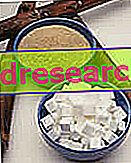Generality
Lewy bodies are small, rounded-shaped protein clusters that typically develop within the brain neurons of people with Parkinson's disease, dementia with Lewy bodies and multi-system atrophy .

Despite the many studies conducted so far, and although there are no other abnormalities within the diseased brain neurons (if not Lewy bodies), the researchers have not yet established precisely how Lewy bodies are involved in the onset of Parkinson's, dementia with Lewy bodies and multi systemic atrophy.
What are Lewy bodies?
Lewy bodies are small insoluble protein aggregates that form in the cytoplasm of brain nerve cells (ie neurons) of people with Parkinson's disease, Lewy body dementia (or dementia with Lewy bodies ), multi systemic atrophy and some familial forms of Alzheimer's disease .
The most important and most representative protein of Lewy bodies is the so - called alpha-synuclein . To this, sometimes, other protein molecules are added such as ubiquitin, the crystalline alpha and the tau protein of microtubules.
The only way to detect Lewy bodies is to analyze brain tissue after death ( post-mortem examination ).
The neurological diseases characterized by the presence of Lewy bodies are also called synucleinopathies, with particular reference to alpha-synuclein.
WHAT IS ALPHA-SINUCLEIN?
Alpha-synuclein is a protein of up to 140 amino acids, encoded by the SNCA gene and particularly abundant in the brain.
Although they have studied it for a long time, the researchers have not yet definitively clarified its function.
According to the most accepted hypothesis, in the encephalic neurons the alpha-synuclein would be located at the level of the presynaptic terminations and, here, it would direct the vesicular transport of important substances called neurotransmitters .
Again based on the scientific studies conducted in this regard, two of these neurotransmitters would be dopamine - which is a substance responsible for the fine control of voluntary and involuntary movements - and acetylcholine - which is involved in muscle contraction and not only.
In the brain, alpha-synuclein can be found in the neurons of the neocortex, the hippocampus, the substantia nigra, the thalamus and the cerebellum. Furthermore, it is also present in glia cells, in mammillary nuclei (an area interposed between the diencephalon and the optic chiasm) and inside the mitochondria of some nerve cells (NB: mitochondria are cellular organelles where ATP is produced) .
According to the latest findings, there are three alpha-synuclein isoforms; to distinguish them is the number of amino acids: 140 for the most common isoform, 126 for alpha-synuclein-126 and 112 for alpha-synuclein-112.
LOCATION OF LEWY BODIES AND TYPOLOGIES
Lewy bodies are spherical masses found in two areas of the brain: in the brainstem and in the cerebral cortex .
The Lewy bodies present in the neurons of the brainstem are structures that, under the microscope, appear as dense, consistent structures surrounded by a very thin halo.
In contrast, the Lewy bodies that form inside the nerve cells of the cerebral cortex are less defined aggregates than the previous ones and without any surrounding halo.
After post-mortem examinations of brain tissue from patients with Parkinson's and dementia with Lewy bodies, it was found that, while Lewy bodies formed in brain stem cells are characteristic of Parkinson's disease, those within neurons of the cerebral cortex are typical of dementia with Lewy bodies.
ORIGIN OF THE NAME
The Lewy bodies are so named because they were discovered in 1912 by a scientist named Frederic Lewy .
Their discovery occurred during a study that F. Lewy was conducting on Parkinson's disease.
LEWY NEURITES
Sometimes the alpha-synuclein can give rise to structures similar to Lewy bodies, called Lewy neurites .
Much less common and known than Lewy bodies, Lewy neurites contain granular material and alpha-synuclein filaments.
Exactly like Lewy bodies, one can find, thanks to an appropriate post-mortem examination, in neurons of people with Parkinson's disease, dementia with Lewy bodies and multi systemic atrophy.
In histological language, the term neurite (male) indicates a prolongation of the neuron, such as an axon or a dendrite.
Therefore it should not be confused with neuritis (female) as an inflammatory process on the cranial or peripheral nerves.
Consequences
The specific presence of Lewy bodies in the cerebral neurons of patients with synucleinopathies has led researchers to consider them the main culprits of these diseases.

Among the various theories proposed, the most accredited one holds that the presence of Lewy bodies is interference with the release of dopamine and acetylcholine neurotransmitters, by presynaptic terminations.
Therefore, again according to the same hypothesis, due to the reduction of dopamine and acetylcholine levels, the interneuronal communication is impaired and the cells involved gradually go to death.
Future prospects
The researchers are of the opinion that, for the realization of an effective cure against synucleinopathies, it is absolutely necessary to clarify two aspects:
- What is the mechanism that leads to the accumulation, in aggregates, of the alpha-synuclein
- The exact role played by Lewy bodies in the onset of the aforementioned pathologies.



